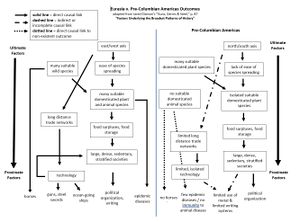Columbian Exchange
- the exchange, or transfer, or plants, animals, disease, people, and cultures to and from the Americas and the rest of the world
- followed the European discovery of the Americans by Christopher Columbus in 1492.
- the Columbian Exchange marks a dramatic turning point in world history with tremendous consequences upon world interactions and outcomes
Background
Having been populated by hunter-gatherers starting 14-20,000 years before Christ and almost no contact, or none with any degree of continuity, with the rest of the world until Columbus' first visit to the Caribbean in 1492, the peoples of the Americans populated the Americas and developed their societies independently of the rest of the world.
In other words, the societies of the Americas evolved independently of the rest of the world and with distinct environmental conditions. While developing agriculture across the Americas, and urbanized population centers with complex governments in some areas, by the time of Columbus' arrival, the peoples of the Americas had not developed technologies that had long before spread across Eurasia and Africa, especially writing and metallurgy.
Additionally, with the geographic axis of the Americas as largely north-south, and with the geographic barriers separating north and south America (and within each), these societies did not as extensively interact with one another as societies had across Eurasia and north Africa. Trade was extensive, but in the absence of geographic facilitators of exchange and the horse, which had gone extinct in the Americas from ice sheet climate change and human hunting.
Columbus

Spanish conquest
- a core question about the Columbian exchange is:
- why did the Spanish invade and conquer the Native Americans and the Native American empires did not invade and conquer Spain?
- Jared Diamond's "Guns, Germs and Steel" explores this question
- Diamond's analysis shows that the "broad" or very long-term causality of the outcome that that Spanish conquered the Americas and not the other way around is due to geography, notably:
- continental axis:
- east-west axis of Eurasia allowed for exchange
- north-south axis of the Americas limited exchange
- domesticable plants
- both regions had an abundance of domesticable plants
- but Eurasia had more available plants
- and given the east-west axis of Eurasia, those plants were spread
- therefore, Eurasian populations arose earlier than those in the Americas
- and centralized societies that might want to attack one or the other arose earlier in Eurasia
- domesticable animals
- the Americas lacked animals that are appropriate for food consumption and transport
- especially the horse
- many contagious diseases originated from human proximity to domesticated animals
- lacking those animals, the Americans had no immunity to Eurasian diseases
- the Americas lacked animals that are appropriate for food consumption and transport
- these combinations yielded advantages to Eurasian societies that the Spanish used in their conquest of the Americas, including
- technologies of guns and steel (used for weapons and tools)
- horses (war horses provided a considerable military advantage)
- especially for mounting soldiers and those metal weapons
- disease, which killed off a tremendous number of Native Americans and weakened their centralized states
- writing system which effectively transmitted information about other people and technologies
- ex. Marco Polo's journeys were tremendously helpful to Europeans as they learned details about China and other places
- Inca and Aztec writing systems existed
- but Inca system of “quipu" beads and strings effectively recorded information but not words
- continental axis:
Plants
- the most important exchange was
- deepest impacts include:
animals from the Americas
- turkeys
plants from the Americas
- beans
- chocolate
- maize (corn)
- potatoes
- sweet potatoes
- tomatoes
diseases from the Americas
- syphilis
animals to the Americas
- chickens
- cows
- horses
- pigs
diseases to the Americas
- malaria (from Africa)
- small pox
plants to the Americas
- apples
- coffee (from Africa)
- wheat
Animals
- the most important exchange was:
- introduction of farm animals to the Americas
- deepest impacts include:
from the Americas
to the Americas
Insects
- the most important exchange was:
- deepest impacts include:
- European honey bees
- English earth worms
- the ice sheet and tundra climat killed the earthworms across northern North America
- introduction of English worms re-worked the soil and changed the ecosystem
from the Americas
to the Americas
Disease
- the most important exchange was:
- deepest impacts include:
from the Americas
to the Americas
Technologies
- the most important exchanges were:
- iron
- gunpowder
- horses
- deepest impacts include:
- increase in deadliness of Native American tribal warfare
- mass killing of North American buffalo herds via horse and firearms use
- North American Native American armed resistance to European encroachment
from the Americas
- rubber
- rubber is a natural latex
- it is a milky-substance, like sap, that is derived from certain tropical trees
- various latex-producing, rubber trees exist around the world
- however, the Brazilian "Rubber Tree" is the primary source of industrial-use rubber
- the Rubber Tree is a native plant of the Amazon (can grow to 140 feet)
- earliest documented use of natural latex (rubber) was by the Olmec civilization in Mesoamerica (central America)
- the Olmec and, later, Maya and Aztec, used rubber for balls for sports
- the Aztec added rubber to cloth to make it waterproof
- see
- Heva Brasiliensis (wiki) for the story of this important plant
- https://www.oringsusa.com/Rubber_Intro.pdf Brief History of Rubber (originsusa.com)]
- rubber is a natural latex
- canoes
- from the Tiaino word <<
- farming techniques
to the Americas
- horses
- iron
- alcohol
Language
- the most important exchange was:
- deepest impacts include:
from the Americas
to the Americas
Other cultural, political and religious exchange
- the most important exchange was:
- deepest impacts include: